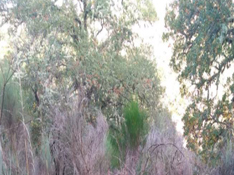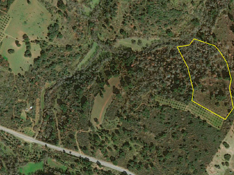- Inicio
- Trabajos en curso
- PILOT NORTH EXPERIENCE of PORTUGAL – Sheep
PILOT NORTH EXPERIENCE of PORTUGAL – Sheep
LOCATION
- Northeast of Portugal, district of Bragança, Sector NW of SIC Romeu
- Coordinates: 41 ° 32’N 7 ° 02’W
- Altitude: 495 -530 m
- Parish: Union of the parishes of Avantos and Romeu (Mirandela)
- Property of the land: particular some own and others rented
PROTECTION FIGURES
Site of Community Interest “Romeu (PTCON 0043)” published in Resolution of the Council of Ministers no. 76/2000 of July 5.
SURFACES OF ACTION
A 3.5 ha plot was selected for the performance of the combined practices of mechanical cleaning and directed grazing and their monitoring. In the plot, a non – cleaned strip was maintained and a grazing exclusion range was established (10 * 40 m2), allowing to compare the evolution of vegetation with and without grazing after mechanical cleaning with chain scraper. Additionally, to demonstrate the evolution of the vegetation in the exclusive presence of traditional grazing. The directed use is complemented by grazing other areas mainly of the “monte” type (spontaneous vegetation that includes grasses, herbaceous and arboreal grasses) and small forage units.
VEGETATION
The SIC is characterized by the domain of the cork oak forests (habitat 9330 Quercus suber) and by the presence of. Juniper (9560 * endemic forests of Juniperus spp.) In good condition in its lowest sector; the presence of holm oak (Quercus ilex and Quercus rotundifolia 9340) and Quercus faginea in the area of experience implementation is relevant. Associated with these species dominate a relatively dense (30-60%) sub-forest of cytisus scoparius and Cytisus multiflorus or stevia (Cystus ladanifer) and arca (Lavandula stoechas) depending on the microecological conditions, sometimes associated with some cover herbaceous The presence of Crataegus monogyna and Prunus spp. in wetter areas associated with Q. faginea is also common.
CLIMATE
Mediterranean with continental influence, characterized by cold and humid winters and hot and dry summers. Average annual temperature of 13oC and average annual rainfall of 700 mm, distributed essentially from October to April.
SOLOS
In the area dominates the dystrophic leptosols derived from shale. These are thin soils (thickness less than 30 cm) with a high content of coarse, acidic elements, poor in organic matter and at risk of moderate erosion.
ENVIRONMENTAL PROBLEM ASSOCIATED WITH THE EP
The reduction of the use pressure on the territory associated to the socioeconomic transformations verified from the second half of the last century have contributed to a homogenization of the landscape, loss of biodiversity and increased fire risk. Forest fire statistics show that, over the past 36 years, Portugal has been the only one among southern European countries that has not been able to significantly reduce the annual average of the burning area. The tragic fires of 2017 once again revealed Portugal’s extreme vulnerability to extreme weather and the urge to find effective means of fuel management.
Fire is the most determinant agent in the loss of value of the forests by direct way of its woody and indirect production by the reduction of goods and services contributed. The current grazing pressure in the area does not have the capacity to maintain the fuel load at a level appropriate to pasture, low fire risk and conservation of open mountain areas. Given the current climate change situation (extreme events and increasingly frequent and more unexpected heat waves), the importance of controlling fuel biomass and favoring less dense, more open and more biodiverse shrub formations is evident.
USE OF CONTROLLED FIRE
In Portugal, the use of fire for the purpose of renewal of pasture – burned is a traditional practice and is regulated by Decree Law no. 14/2019 of January 21, its realization is only allowed after authorization of the municipality, taking into account the proposal to carry out the burn, the meteorological and operational framework, as well as the date and place where it is proposed. It lacks follow-up, through the presence of an accredited technician in controlled or operational fire of burning or, in his absence, of a team of firefighters or of a team of foresters. With this legislation (Decree Law no. 14/2019 of January 21), changes were also introduced as a result of the creation of the informatics platform for extensive burning and burning, available on the website of the Institute of Nature Conservation and Forestry, I.P.
Considering the typology of fires (many occurrences and few burnt areas) of the municipality of Mirandela, which is inserted in Terra Quente Transmontana – area of the pilot experience, which are of human origin and most of these ignitions are associated with negligence due to misuse of the it is important to implement a culture of prevention in order to reduce the number of ignitions and the impacts that may occur.
FLOCK
In the zone of intervention and adjoining areas of the parish term shepherds a flock of Churra Galega Bragançana sheep with about 190 females for meat production. This breed is included in the group that is supported by the Regional Development Plan (EAFRD, Decree-Law no. 137/2014 of 12 September) under the heading <Maintenance of indigenous breeds at risk> is classified as grade C ; currently the breed has 9,138 animals registered in the Genealogical Book, distributed by 362 breeders. Feeding of the herd is based on grassland grazing and spontaneous herbaceous pastures (about 9-10 h day-1) supplemented with some fodder in the most demanding periods. For the pilot experiment, the whole herd is scheduled to be grazed during the spring and fall until the forage resources are exhausted. The GPS technology will allow to gauge the number of hours and days and grazing load actually practiced in the pilot experience area.
LIVESTOCK INFRASTRUCTURES AND ACCESS
Access to the experimental portion by the Transmontana – A4 motorway to the Romeu junction, and then taking the EN 102-1 road (northbound), you reach the parcel through a rural road. The infrastructures of the herd’s owner consist of a corral with mangers and drinking fountains and a containment sleeve and foot bath.


Date:
06 July 2019
#CalidadSuelosAplicacionesMedioambiente













